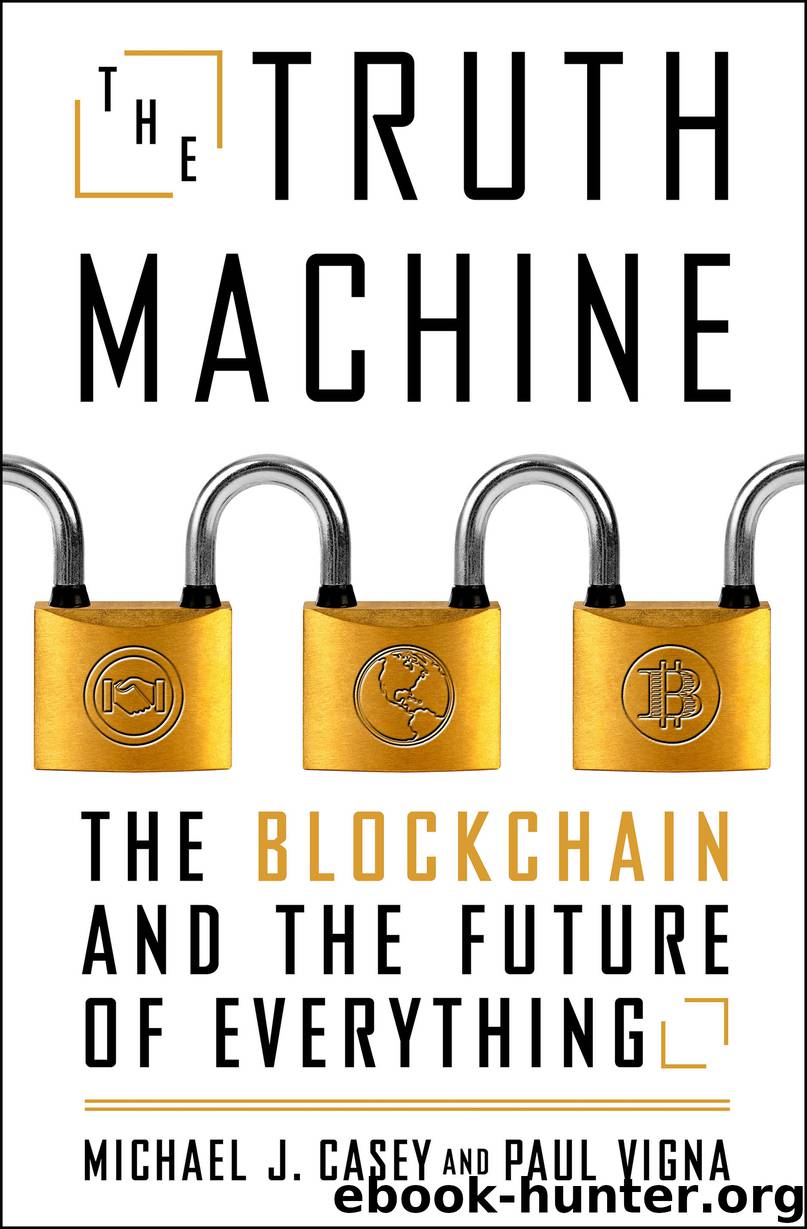The Truth Machine by Paul Vigna

Author:Paul Vigna
Language: eng
Format: epub
Publisher: St. Martin's Press
Six
THE OLD GUARD’S NEW MAKEOVER
On August 5, 2015, Bitcoin came to Wall Street. Or, to be more precise, a new, more buttoned-down version of Bitcoin came to Wall Street.
In its early days, bankers who’d heard of Bitcoin viewed it as a mere curiosity. Its wildly volatile price might make for a fun speculative investment, but the instability ruled Bitcoin out as an alternative currency. As far as bankers were concerned, Bitcoin had no role to play in the existing financial system. Banking institutions thrive on a system of opacity in which our inability to trust each other leaves us dependent on their intermediation of our transactions. Bankers might give lip service to reforming the inner workings of their system, but the thought of turning it over to something as uncontrollable as Bitcoin was beyond heresy. It wasn’t even conceivable.
At the same time, committed Bitcoin fans weren’t much interested in Wall Street, either. Bitcoin, after all, was designed as an alternative to the existing banking system. An improvement. Truth be told, despite an impressive movement that had coalesced around this upstart cryptocurrency in the almost seven years before the August 2015 event, and despite the innovations and the myriad other cryptocurrencies and networks and possibilities it had spawned, Bitcoin really hadn’t made much of a dent in reshaping the old order. Wall Street’s money machine remained firmly at the center of the global economy—and still does. For now, if you want to use technology to improve the world of finance—to reduce systemic risk in bond markets, for example, or make it easier for the poor to send and receive money—you still need to talk to Wall Street.
That’s what a group of technologists from the startup Symbiont set out to do on that sunny August day in 2015. They took their new, less subversive version of Bitcoin downtown, and while their model was better described as “inspired” by Bitcoin than as a close copy of it, they still promised a revolution, if a more controlled one. Among the Bitcoin-like features their model contained were the vital elements of a distributed ledger, a capacity to transfer digitized assets peer-to-peer, and low-cost and near-instantaneous transactions. But Symbiont had jettisoned other Bitcoin features, including those that obviate the need for banks as payment intermediaries. Most notably, this system did not include its own native cryptocurrency for rewarding miners and for maintaining a permissionless system of validation. In essence, Symbiont was promising “blockchain without bitcoin”—it would maintain the fast, secure, and cheap distributed network model, and a truth machine at its center that validated transactions, but it was not leaderless, permissionless, and open to all. It was a blockchain that Wall Street could control.
Whether it’s possible to separate bitcoin, ether, or any cryptocurrency from a blockchain is yet to be long-term tested. Some digital currency aficionados argue that stripping out the internal cryptocurrency would destroy the integrity of a blockchain. Without a native digital currency with which to reward and incentivize transaction validation, a permissionless network
Download
This site does not store any files on its server. We only index and link to content provided by other sites. Please contact the content providers to delete copyright contents if any and email us, we'll remove relevant links or contents immediately.
Effective Threat Investigation for SOC Analysts by Yahia Mostafa;(7379)
Practical Memory Forensics by Svetlana Ostrovskaya & Oleg Skulkin(7099)
Machine Learning Security Principles by John Paul Mueller(7065)
Attacking and Exploiting Modern Web Applications by Simone Onofri & Donato Onofri(6725)
Operationalizing Threat Intelligence by Kyle Wilhoit & Joseph Opacki(6709)
Solidity Programming Essentials by Ritesh Modi(4522)
Microsoft 365 Security, Compliance, and Identity Administration by Peter Rising(4104)
Operationalizing Threat Intelligence by Joseph Opacki Kyle Wilhoit(3855)
Learn Computer Forensics - Second Edition by William Oettinger(3597)
Building a Next-Gen SOC with IBM QRadar: Accelerate your security operations and detect cyber threats effectively by Ashish M Kothekar(3568)
Future Crimes by Marc Goodman(3519)
Blockchain Basics by Daniel Drescher(3495)
Mastering Azure Security by Mustafa Toroman and Tom Janetscheck(3470)
Mastering Python for Networking and Security by José Manuel Ortega(3451)
Incident Response with Threat Intelligence by Roberto Martínez(3334)
The Code Book by Simon Singh(3073)
Mastering Bitcoin: Programming the Open Blockchain by Andreas M. Antonopoulos(2980)
Mobile App Reverse Engineering by Abhinav Mishra(2957)
From CIA to APT: An Introduction to Cyber Security by Edward G. Amoroso & Matthew E. Amoroso(2857)
